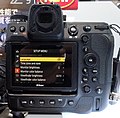 Nikon Z9 + Nikkor Z 24-70 mm f/2.8 S | |
| Overview | |
|---|---|
| Maker | Nikon |
| Type | Full-frame mirrorless interchangeable-lens camera |
| Released | 24 December 2021 |
| Intro price | JPY 700,000 (body only) USD 5,500 |
| Lens | |
| Lens mount | Nikon Z-mount |
| Sensor/medium | |
| Sensor type | Stacked back-illuminated CMOS sensor |
| Sensor size | Full frame (35.9 x 23.9 mm) Nikon FX format |
| Sensor maker | Sony [1] |
| Maximum resolution | 8,256 x 5,504 (45.7 effective megapixels) |
| Film speed | Native range of ISO 64-25,600 (expandable to 32-102,400) |
| Recording medium | 2 × CFexpress Type B / XQD |
| Focusing | |
| Focus |
|
| Focus modes |
|
| Focus areas | 493 points (single-point AF) with 90% coverage |
| Exposure/metering | |
| Exposure | TTL metering using camera image sensor |
| Exposure modes |
|
| Exposure metering | TTL metering using camera image sensor Highlight-weighted metering: -3 to +17 EV (ISO 100, f/2.0 lens, 20 °C/68 °F) |
| Metering modes | Matrix metering Center-weighted metering Spot metering Highlight-weighted metering |
| Flash | |
| Flash | Built-in: No Hot shoe |
| Flash synchronization | 1/200s (up to 1/8000s using high-speed sync) |
| Shutter | |
| Frame rate | Up to 120 fps in 11 MP continuous (C120), up to 60 fps in 19MP continuous (C60), up to 30 fps at full-resolution with JPEG output (C30), up to 20 fps with RAW output |
| Shutter | Electronic shutter |
| Shutter speeds | 900s – 1/32000s |
| Continuous shooting | 20 fps / 30 fps / 120 fps (expand) |
| Viewfinder | |
| Viewfinder | Quad-VGA (1280x960) EVF (3690000 dots), 0.8x magnification with 50 mm lens, 3000 nits brightness, 120 Hz refresh rate |
| Image processing | |
| Image processor | Expeed 7 |
| White balance |
|
| General | |
| Video recording | 8.3K up to 60 fps in 12-bit N-RAW, 8K up to 30 fps with N-log, 4.1K up to 60 fps in 12-bit ProRes RAW HQ, 4K up to 120 fps, 1080p up to 120 fps |
| LCD screen | 3.2-inch vertically and horizontally tilting TFT LCD with 2.1 million dots with touchscreen |
| Battery | EN-EL18d USB-C PD rechargeable (EN-EL18/a/b/c useable with lower battery life) |
| Optional accessories | MC-N10 remote grip (fw. 3.00+) |
| AV port(s) | USB Type-C, HDMI Type-A, 3.5 mm microphone jack, 3.5 mm headphone jack circular 10-pin accessory port |
| Data port(s) | IEEE 802.11b/g/n/a/ac/Wi-Fi, Bluetooth Low Energy, Gigabit Ethernet |
| Body features | In-Body Image Stabilization, GPS receiver |
| Dimensions | 149×149.5×90.5 mm (5.87×5.89×3.56 in) |
| Weight | 1,340 g (47 oz) (with battery, memory card) 1160g (body only) |
| Latest firmware | 5.30 / 16 December 2025 [3] |
| Made in | Thailand |

The Nikon Z9 is a flagship full-frame mirrorless camera produced by Nikon. The camera was announced on October 28, 2021. It is the eighth Z-mount camera body and the sixth full-frame Z-mount body.
Contents
- Image sensor and processor
- Lenses
- Features
- Z9 generation
- Use in outer space
- Gallery
- Awards
- Update history
- References
- External links
When launched, Nikon used the marketing slogan: “Unstoppable.” [4]




